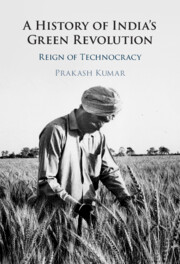Refine search
Actions for selected content:
103 results
3 - Coping with Disaster
-
- Book:
- The Nature of the Ottoman City
- Published online:
- 28 August 2025
- Print publication:
- 11 September 2025, pp 115-166
-
- Chapter
- Export citation
Conclusion
-
- Book:
- A History of India's Green Revolution
- Published online:
- 07 August 2025
- Print publication:
- 21 August 2025, pp 193-206
-
- Chapter
- Export citation

A History of India's Green Revolution
- Reign of Technocracy
-
- Published online:
- 07 August 2025
- Print publication:
- 21 August 2025
6 - The Holocaust and Modernity
-
-
- Book:
- The Cambridge History of the Holocaust
- Published online:
- 16 May 2025
- Print publication:
- 12 June 2025, pp 113-133
-
- Chapter
- Export citation
Through the Prism of Community Development: Decolonization and the Cold War Politics of Agrarian Modernization in East Pakistan
-
- Journal:
- Social Science History , First View
- Published online by Cambridge University Press:
- 16 May 2025, pp. 1-25
-
- Article
- Export citation
What Was and Is “1968”?: Japanese Experience in Global Perspective
-
- Journal:
- Asia-Pacific Journal / Volume 16 / Issue 11 / June 2018
- Published online by Cambridge University Press:
- 14 March 2025, e6
-
- Article
-
- You have access
- Open access
- Export citation
Between a Forgotten Colony and an Abandoned Prefecture: Okinawa's Experience of Becoming Japanese in the Meiji and Taishō Eras
-
- Journal:
- Asia-Pacific Journal / Volume 18 / Issue 20 / October 2020
- Published online by Cambridge University Press:
- 14 March 2025, e7
-
- Article
-
- You have access
- Open access
- Export citation
The “Unrelated” Spirits of Aoyama Cemetery: A 21st Century Reckoning with the Foreign Employees of the Meiji Period
-
- Journal:
- Asia-Pacific Journal / Volume 19 / Issue 8 / April 2021
- Published online by Cambridge University Press:
- 14 March 2025, e1
-
- Article
-
- You have access
- Open access
- Export citation
Fixing Blue Mondays with the Sunny Monday Machine: Rural Midwestern Farm Companies’ Offseason Gas-Powered Washing Machine Production, 1907–1929
-
- Journal:
- Enterprise & Society , First View
- Published online by Cambridge University Press:
- 06 March 2025, pp. 1-30
-
- Article
-
- You have access
- Open access
- HTML
- Export citation
19 - Vietnam and American Race Relations
- from Part II - Homefronts
-
-
- Book:
- The Cambridge History of the Vietnam War
- Published online:
- 02 January 2025
- Print publication:
- 28 November 2024, pp 406-427
-
- Chapter
- Export citation
5 - Germany’s Entangled Modernities
- from Part II - Liberty, Unity, Equality: 1840–1870
-
- Book:
- Germany through Jewish Eyes
- Published online:
- 14 November 2024
- Print publication:
- 21 November 2024, pp 78-92
-
- Chapter
- Export citation
Chapter 10 - The Politics of Disenchantment
-
-
- Book:
- A History of Haitian Literature
- Published online:
- 07 November 2024
- Print publication:
- 21 November 2024, pp 175-193
-
- Chapter
- Export citation
3 - Habitus in the Postcolony
- from Part I - Making Journalists
-
- Book:
- In the Shadow of the Global North
- Published online:
- 13 November 2024
- Print publication:
- 07 November 2024, pp 48-72
-
- Chapter
- Export citation
Chapter 4 - 1884: A Literary Field in Formation
- from Part I - Literary Dates
-
-
- Book:
- A History of Argentine Literature
- Published online:
- 09 May 2024
- Print publication:
- 16 May 2024, pp 52-66
-
- Chapter
- Export citation
Chapter 8 - 1963: Experimentation and the Common Reader
- from Part I - Literary Dates
-
-
- Book:
- A History of Argentine Literature
- Published online:
- 09 May 2024
- Print publication:
- 16 May 2024, pp 112-132
-
- Chapter
- Export citation
5 - Varieties of Gacaca; or: The Invention of Tradition
- from Part IV - The Evolution of Lawfare
-
- Book:
- The Violence of Law
- Published online:
- 30 April 2024
- Print publication:
- 02 May 2024, pp 195-246
-
- Chapter
- Export citation
1 - Oceania and the Study of Regions
-
- Book:
- Regional Politics in Oceania
- Published online:
- 15 February 2024
- Print publication:
- 22 February 2024, pp 1-32
-
- Chapter
- Export citation
9 - The Japanese Empire
- from Part I - Imperial and Postcolonial Settings
-
-
- Book:
- The Cambridge History of Nationhood and Nationalism
- Published online:
- 08 November 2023
- Print publication:
- 09 November 2023, pp 179-209
-
- Chapter
- Export citation
Chapter 11 - “Through a Narrow Glass”: Compassion, Power, and Lyndon Johnson’s Struggle to Make Sense of the Third World
-
-
- Book:
- LBJ's America
- Published online:
- 19 October 2023
- Print publication:
- 19 October 2023, pp 281-302
-
- Chapter
- Export citation
